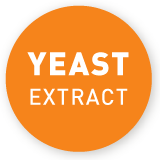Many consumers immediately think of the flavour enhancer monosodium glutamate when they hear the term “glutamate”. What most people are not aware of is: Glutamate is the sodium salt of glutamic acid which is an amino acid and our daily diet would be unthinkable without it. It even occurs in our own bodies.
Glutamate occurs naturally in all protein-rich food sources. It also forms naturally in foodstuffs due to enzymatic ripening processes. In fact, the amino acid occurs in so many foodstuffs that we can hardly avoid consuming it: Whether we bite into a tasty cheese sandwich, eat an aromatic mushroom dish or enjoy a fresh salad with tomatoes – glutamate is contained in cheese, mushrooms and ripe tomatoes. The amino acid occurs even in substantial quantities in many popular dishes. A good example is spaghetti Bolognese with parmesan: The high overall glutamate content of this dish does not only stem from the contained meat and tomatoes, but rather and in particular from the savoury parmesan cheese. The ingredient yeast extract also contains glutamate, since the amino acid occurs naturally in the yeast that yields the extract, whereas the additive monosodium glutamate consists of glutamate in the form of an isolated pure substance. That is why, by food law, it must be declared as a flavour enhancer.
For many, the fact that the amino acid is formed in the human body is even more surprising than the natural occurrence of glutamate in foodstuffs. The expert Prof. Dr. Thomas Vilgis from the Max-Planck-Institute for Polymer Research in Mainz, Germany explains: “There is always more than 50 grams of the substance in the human body, since the body also produces glutamic acid itself when digesting proteins. With each food intake, an average of ten to twenty grams of bound and one gram of free glutamic acid are added. Even breast-milk contains glutamate.”



